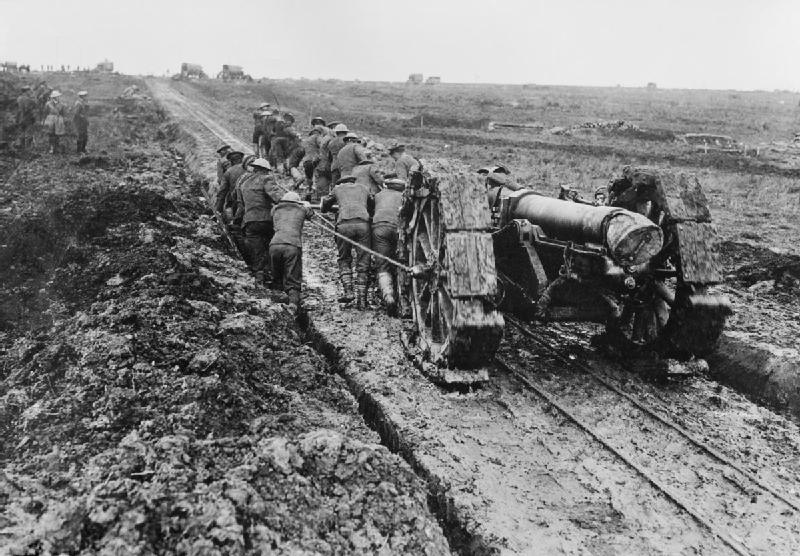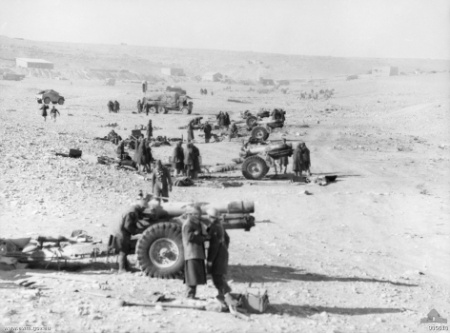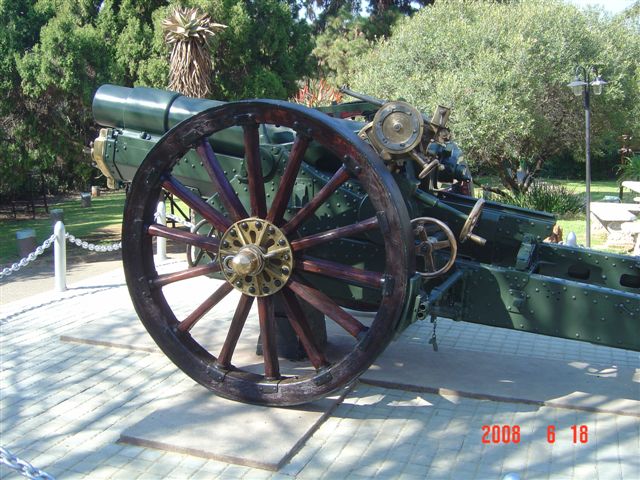BL 6-inch 26 cwt howitzer on:
[Wikipedia]
[Google]
[Amazon]
The Ordnance BL 6 inch 26cwt howitzer was a British howitzer used during


 It was developed to replace the obsolescent 6 inch 25 cwt and 6 inch 30 cwt howitzers which were outclassed by German artillery such as the 15 cm schwere Feldhaubitze 13. Design began in January 1915, the first proof-firing occurred on 30 July 1915 and it entered service in late 1915.Hogg & Thurston 1972, Page 126-127 Its combination of firepower, range and mobility (for its day) made it one of the British Empire's most important weapons in World War I.
It was originally towed by horses but from 1916 onwards was commonly towed by the FWD 4 wheel drive 3 ton lorry as heavy field artillery. The wooden spoked wheels could be fitted with "girdles" for work in mud or sand to prevent them sinking. Towards the end of the war solid rubber tyres were fitted over the iron tyres on the wheel rims, giving the rims a heavier appearance. It fired 22.4 million rounds on the Western Front.Clarke 2005, page 37
It was developed to replace the obsolescent 6 inch 25 cwt and 6 inch 30 cwt howitzers which were outclassed by German artillery such as the 15 cm schwere Feldhaubitze 13. Design began in January 1915, the first proof-firing occurred on 30 July 1915 and it entered service in late 1915.Hogg & Thurston 1972, Page 126-127 Its combination of firepower, range and mobility (for its day) made it one of the British Empire's most important weapons in World War I.
It was originally towed by horses but from 1916 onwards was commonly towed by the FWD 4 wheel drive 3 ton lorry as heavy field artillery. The wooden spoked wheels could be fitted with "girdles" for work in mud or sand to prevent them sinking. Towards the end of the war solid rubber tyres were fitted over the iron tyres on the wheel rims, giving the rims a heavier appearance. It fired 22.4 million rounds on the Western Front.Clarke 2005, page 37
 During the interwar period the carriage had its wooden spoked wheels replaced with modern steel wheels and pneumatic tyres. During World War II, its use was restricted after 1942 when the replacement BL 5.5 inch Medium Gun came into use but it was reintroduced in Burma due to a number of premature detonations in guns. It was declared obsolete with the end of the war in 1945.
Captured examples received the designation FH-412(e) in German use.
During the interwar period the carriage had its wooden spoked wheels replaced with modern steel wheels and pneumatic tyres. During World War II, its use was restricted after 1942 when the replacement BL 5.5 inch Medium Gun came into use but it was reintroduced in Burma due to a number of premature detonations in guns. It was declared obsolete with the end of the war in 1945.
Captured examples received the designation FH-412(e) in German use.

Royal Artillery Museum, Woolwich, LondonArmy Memorial Museum, Waiouru, New ZealandRoyal Australian Artillery Museum
North Head, Sydney, Australia
Rovereto (Italy) *South Africa : The Imperial Government presented 6 howitzers to the Union of South Africa after World War I and the six South African Heavy Artillery Memorials were designed, commissioned and paid for by the South African Heavy Artillery Association to honour their fallen Comrades-in-Arms : Memorial to 71st (Transvaal) Siege Battery at Johannesburg Zoo (restored); 72nd (Griqualand West) Siege Battery at Clyde N Terry Museum, Kimberley; 73rd (Cape) Siege Battery at Company Gardens, Cape Town; 74th (Eastern Province) Siege Battery at National Museum, Bloemfontein (Restoration is about to begin, May 2009); 75th (Natal) Siege Battery, Warriors' Gate MOTH Shellhole, Old Fort Road, Durban; 125th (Transvaal) Siege Battery near the Union Buildings, Pretoria. These guns are being restored by the Gunner's Association of South Africa * National Museum of Military History, Saxonwold, Johannesburg, South Africa
The Central Museum of The Royal Regiment of Canadian Artillery, Shilo Manitoba
*Barracks Green Armouries, Belonging to and restored by 3rd Field Regt.(The Loyal Company), Saint John, New Brunswick
File:BL 6-inch 26 cwt howitzer 4 lb 11.5 oz cordite MD or RDB cartridge Mark II diagrams.jpg, 4lb 11½oz
British Artillery 1914-1919. Heavy Artillery. Osprey Publishing, Oxford UK, 2005
* General Sir Martin Farndale, History of the Royal Regiment of Artillery. Western Front 1914-18. London: Royal Artillery Institution, 1986. * I.V. Hogg & L.F. Thurston, British Artillery Weapons & Ammunition 1914-1918. London: Ian Allan, 1972.
Handbook of the B.L. 6-inch 26-cwt. Mark I howitzer on Mark I travelling carriage, (land service), 1919.
Hosted online by State Library of Victoria, Australia
Gun drill for 6-inch B.L. 26-cwt howitzer Mark I carriage Mark I 1920
Hosted online by State Library of Victoria, Australia
Gun drill for B.L. 6-inch 26 cwt howitzer Mark 1 carriage Mark 1 1926
Hosted online by State Library of Victoria, Australia *
Video clips on YouTube
* Nigel F Evans
* W L Ruffell
* ttps://karaya.one/albums/index.php?/category/18 Walk around BL 6-inch 26-cwt howitzer WWI exposed to the Sacrario Militare di Redipuglia / Italy {{DEFAULTSORT:BL 06 inch 26 cwt howitzer World War I artillery of the United Kingdom World War II artillery of the United Kingdom World War I howitzers 152 mm artillery World War II howitzers
World War I
World War I (28 July 1914 11 November 1918), often abbreviated as WWI, was one of the deadliest global conflicts in history. Belligerents included much of Europe, the Russian Empire, the United States, and the Ottoman Empire, with fightin ...
and World War II
World War II or the Second World War, often abbreviated as WWII or WW2, was a world war that lasted from 1939 to 1945. It involved the vast majority of the world's countries—including all of the great powers—forming two opposing ...
. The qualifier "26cwt" refers to the weight of the barrel and breech together which weighed .
History
World War I


 It was developed to replace the obsolescent 6 inch 25 cwt and 6 inch 30 cwt howitzers which were outclassed by German artillery such as the 15 cm schwere Feldhaubitze 13. Design began in January 1915, the first proof-firing occurred on 30 July 1915 and it entered service in late 1915.Hogg & Thurston 1972, Page 126-127 Its combination of firepower, range and mobility (for its day) made it one of the British Empire's most important weapons in World War I.
It was originally towed by horses but from 1916 onwards was commonly towed by the FWD 4 wheel drive 3 ton lorry as heavy field artillery. The wooden spoked wheels could be fitted with "girdles" for work in mud or sand to prevent them sinking. Towards the end of the war solid rubber tyres were fitted over the iron tyres on the wheel rims, giving the rims a heavier appearance. It fired 22.4 million rounds on the Western Front.Clarke 2005, page 37
It was developed to replace the obsolescent 6 inch 25 cwt and 6 inch 30 cwt howitzers which were outclassed by German artillery such as the 15 cm schwere Feldhaubitze 13. Design began in January 1915, the first proof-firing occurred on 30 July 1915 and it entered service in late 1915.Hogg & Thurston 1972, Page 126-127 Its combination of firepower, range and mobility (for its day) made it one of the British Empire's most important weapons in World War I.
It was originally towed by horses but from 1916 onwards was commonly towed by the FWD 4 wheel drive 3 ton lorry as heavy field artillery. The wooden spoked wheels could be fitted with "girdles" for work in mud or sand to prevent them sinking. Towards the end of the war solid rubber tyres were fitted over the iron tyres on the wheel rims, giving the rims a heavier appearance. It fired 22.4 million rounds on the Western Front.Clarke 2005, page 37
World War II
 During the interwar period the carriage had its wooden spoked wheels replaced with modern steel wheels and pneumatic tyres. During World War II, its use was restricted after 1942 when the replacement BL 5.5 inch Medium Gun came into use but it was reintroduced in Burma due to a number of premature detonations in guns. It was declared obsolete with the end of the war in 1945.
Captured examples received the designation FH-412(e) in German use.
During the interwar period the carriage had its wooden spoked wheels replaced with modern steel wheels and pneumatic tyres. During World War II, its use was restricted after 1942 when the replacement BL 5.5 inch Medium Gun came into use but it was reintroduced in Burma due to a number of premature detonations in guns. It was declared obsolete with the end of the war in 1945.
Captured examples received the designation FH-412(e) in German use.
Surviving examples

Royal Artillery Museum, Woolwich, London
North Head, Sydney, Australia
Rovereto (Italy) *South Africa : The Imperial Government presented 6 howitzers to the Union of South Africa after World War I and the six South African Heavy Artillery Memorials were designed, commissioned and paid for by the South African Heavy Artillery Association to honour their fallen Comrades-in-Arms : Memorial to 71st (Transvaal) Siege Battery at Johannesburg Zoo (restored); 72nd (Griqualand West) Siege Battery at Clyde N Terry Museum, Kimberley; 73rd (Cape) Siege Battery at Company Gardens, Cape Town; 74th (Eastern Province) Siege Battery at National Museum, Bloemfontein (Restoration is about to begin, May 2009); 75th (Natal) Siege Battery, Warriors' Gate MOTH Shellhole, Old Fort Road, Durban; 125th (Transvaal) Siege Battery near the Union Buildings, Pretoria. These guns are being restored by the Gunner's Association of South Africa * National Museum of Military History, Saxonwold, Johannesburg, South Africa
The Central Museum of The Royal Regiment of Canadian Artillery, Shilo Manitoba
*Barracks Green Armouries, Belonging to and restored by 3rd Field Regt.(The Loyal Company), Saint John, New Brunswick
World War I ammunition
Projectiles used in World War I weighed . A lighter long-range projectile was introduced in November 1918, too late to see service in the warcordite
Cordite is a family of smokeless propellants developed and produced in the United Kingdom since 1889 to replace black powder as a military propellant. Like modern gunpowder, cordite is classified as a low explosive because of its slow burn ...
cartridge
Cartridge may refer to:
Objects
* Cartridge (firearms), a type of modern ammunition
* ROM cartridge, a removable component in an electronic device
* Cartridge (respirator), a type of filter used in respirators
Other uses
* Cartridge (surname), a ...
File:6-inch BL or QF Mk XIIA common pointed artillery shell diagram.jpg, Common pointed 100lb shell Mark XIIA
File:BL 6 inch 26 cwt howitzer chemical shell light Mk VIII diagram.jpg, 100lb chemical shell Mark VIII
File:BL 6 inch 26 cwt howitzer high explosive light shell Mark XVI diagram.jpg, High explosive
An explosive (or explosive material) is a reactive substance that contains a great amount of potential energy that can produce an explosion if released suddenly, usually accompanied by the production of light, heat, sound, and pressure. An ...
100lb shell Mark XVI
See also
*BL 6 inch 30 cwt howitzer
The Ordnance BL 6 inch 30cwt howitzer was a British medium howitzer used in the Second Boer War and early in World War I. The qualifier "30cwt" refers to the weight of the barrel and breech together which weighed 30 hundredweight (cwt) : 30 × ...
: British predecessor
*List of howitzers
Howitzers are one of two primary types of field artillery. Historically, howitzers fired a heavy shell in a high-trajectory from a relatively short barrel and their range was limited but they were slightly more mobile than similar size field gun ...
Weapons of comparable role, performance and era
*Canon de 155 C modèle 1917 Schneider
The Canon de 155 C modèle 1917 Schneider, often abbreviated as the ''C17S'', was a French howitzer designed by Schneider. It was essentially the ''Canon de 155 C modèle 1915 Schneider'' fitted with a different breech to use bagged propellant r ...
French equivalent
*15 cm sFH 13
The 15 cm schwere Feldhaubitze 13 (15 cm sFH 13), was a heavy field howitzer used by Germany in World War I and the beginning of World War II.
History
The gun was a development of the previous standard howitzer, the 15 cm sFH 02. ...
German equivalent
*152 mm howitzer M1910
The 152 mm howitzer Model 1910 Schneider or, more properly, ' as it was designated in Tsarist times, was a French howitzer designed by Schneider et Cie. It was used by the Russian Empire and the Soviet Union during World War I, the Polish– ...
Russian equivalent
Notes and references
Bibliography
* Dale ClarkeBritish Artillery 1914-1919. Heavy Artillery. Osprey Publishing, Oxford UK, 2005
* General Sir Martin Farndale, History of the Royal Regiment of Artillery. Western Front 1914-18. London: Royal Artillery Institution, 1986. * I.V. Hogg & L.F. Thurston, British Artillery Weapons & Ammunition 1914-1918. London: Ian Allan, 1972.
External links
Handbook of the B.L. 6-inch 26-cwt. Mark I howitzer on Mark I travelling carriage, (land service), 1919.
Hosted online by State Library of Victoria, Australia
Gun drill for 6-inch B.L. 26-cwt howitzer Mark I carriage Mark I 1920
Hosted online by State Library of Victoria, Australia
Gun drill for B.L. 6-inch 26 cwt howitzer Mark 1 carriage Mark 1 1926
Hosted online by State Library of Victoria, Australia *
Video clips on YouTube
* Nigel F Evans
* W L Ruffell
* ttps://karaya.one/albums/index.php?/category/18 Walk around BL 6-inch 26-cwt howitzer WWI exposed to the Sacrario Militare di Redipuglia / Italy {{DEFAULTSORT:BL 06 inch 26 cwt howitzer World War I artillery of the United Kingdom World War II artillery of the United Kingdom World War I howitzers 152 mm artillery World War II howitzers